INHERITANCE
The laws of genetic inheritance were first laid down in the 1860s by an Austrian Monk called Gregor Mendel. He noticed that if pea plants producing purple flowers were pollinated by white flowered pea plants, the resulting seeds all produced plants with purple coloured flowers. However, crossing these F1 offspring with each other produced an F2 population of plants in which three-quarters produced purple flowers and one-quarter produced white flowers, i.e. a 3:1 ratio.
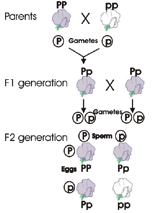
How does this inheritance of flower colour in pea plants relate to us? Sexual reproduction in humans occurs with the fusing of two gametes (the oocyte and sperm) each with one half of the pairs of 23 chromosomes. The resulting zygote therefore inherits one copy of a chromosome, with the respective genes, from each parent. When an identical mutated gene or allele is inherited from each of the two parents, the individual is referred to as a homozygote as they have two copies of the same gene; a heterozygote refers to the presence of only one copy of a particular allele. A Mendelian trait or disease is one that is controlled by a single gene mutation and shows a simple Mendelian inheritance pattern – either dominant or recessive. When an organism has two different variants (alleles) for a trait, the allele that is expressed, overshadowing the expression of the other allele, is said to be dominant (i.e. the purple flower – denoted by P in the diagram). The gene whose expression is overshadowed is said to be recessive (i.e. the white flower – denoted by p in the diagram).
Other patterns of inheritance occur if a gene is on the X chromosome (sex-linked) or mitochondrial DNA (mitochondrial inheritance). Furthermore, there are many disorders that involve a number of different genes (referred to as polygenic) or are influenced by other genes in combination with the environment, which are termed multifactorial and inherited in a non-mendelian fashion.
DOMINANT INHERITANCE
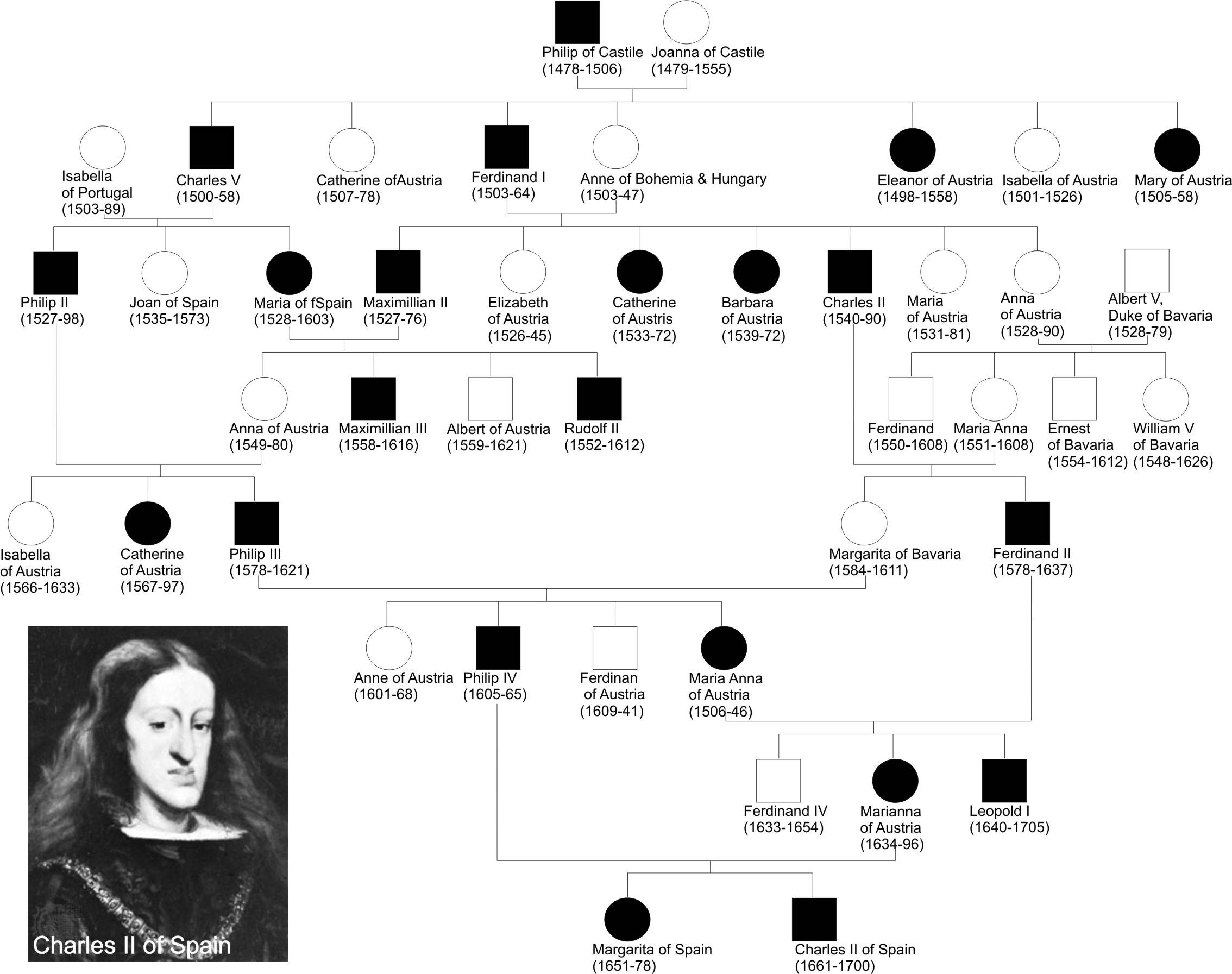
An example of a dominantly inherited trait can be seen in the presence of the Habsburg jaw in the family tree of the Habsburgs. They passed on a gene for an inherited condition known as mandibular prognathism which, in mild forms, is relatively common and causes a jutting jaw or drooping lower lip.
This shows a pattern whereby the gene allele for the Habsburg jaw (H) is dominant over a normal shaped jaw (h). Therefore, heterozygotes (H/h) containing both an allele for the Habsburg jaw and one for a normal jaw will nevertheless be born with the Habsburg jaw. If two heterozygous (H/h) parents produce children, then there is one chance in four of any of their offspring inheriting both attached alleles (h) and so having an abnormal jaw; the classic 3:1 ratio among offspring of heterozygous parents.


If one parent is homozygous for the Habsburg jaw (H/H), even if the other parent has a normal jaw (h/h), then all children will have the Habsburg jaw, i.e. they will be heterozygotes (H/h).
If both parents have normal jaws, and are therefore homozygotes (h/h), then all offspring will have normal jaws also. However, if one parent is heterozygous (H/h) while the other has a normal jaw (h/h), then there is a 50% chance that any child will have a normal jaw or the Habsburg jaw, a 1:1 ratio.


The inherited characteristic of the Habsburg jaw or lip had been passed through generations of the family for as far back as 1421 when a jutting jawed princess Zimburg of Masovia married one of the Habsburg princes.
For the next 300 years, at least, the jaw deformity would remain a defining feature of one of the greatest European dynasties. Indeed, it appears evident from portraits that members of the family were very keen to parade their underbites as a mark of royalty. If we look at just the Spanish members of the Habsburgs, starting with the aptly named Philip ‘the Handsome’ and his wife Joanna ‘the Mad’ of Castile, we can see that both male and female members of the family at each generation were affected, ending with the unfortunate Charles II. Charles II’s parents, who were uncle and niece, both appeared to have the Habsburg jaw and so possibly passed on a double dose of the gene to their hapless son who was consequently born with a hugely misshapen jaw that prevented him from eating or speaking properly.As a consequence of his deformed head and the familial madness from Joanna he was unable to produce an heir to the Spanish throne. Instead, throughout his rule he became increasingly mentally and physically decrepit and his eventual death precipitated the War of the Spanish succession that would last for over a decade and involve much of Europe.
The ancient taboo of incest in most cultures probably stems from the realisation that inbreeding, particularly within the first generation, leads to higher occurrences of children born with defects. The reason inbreeding is so deadly to a population is that, while normally only a small minority of the general population will carry a copy of a particular gene causing a specific recessive disease (i.e the chance of marrying a carrier of the same recessive gene is low), this chance will increase if the individuals are related and hence share some genetic material. Therefore, some recessively inherited conditions are found in higher frequencies in some close-knit communities such as Amish or various Jewish communities. Another example of inbreeding leading to higher incidents of genetic diseases can be seen in the Negev Bedouin people, a population of 140,000 people who roam the Negev desert in Southern Israel. Their tradition is to marry within the family so as to strengthen bonds among extended families; around 65% marry their 1st or 2nd cousins. Although they do not carry any more mutations than the general population, because so many marry relatives they have a higher chance of marrying someone carrying the same mutation increasing the odds of producing a child with a recessive genetic disease. In fact, many of the diseases seen in the Bedouin are extremely rare, resulting from mutations not previously seen in other populations of the world, due to their cultural isolation.
RECESSIVE
One example of recessive inheritance can be seen in the appearance of earlobes; some people have the lobe hanging free (detached ear lobes) while others have the lobe attached to their head. This can be seen in the British royal family, judging from photographs.
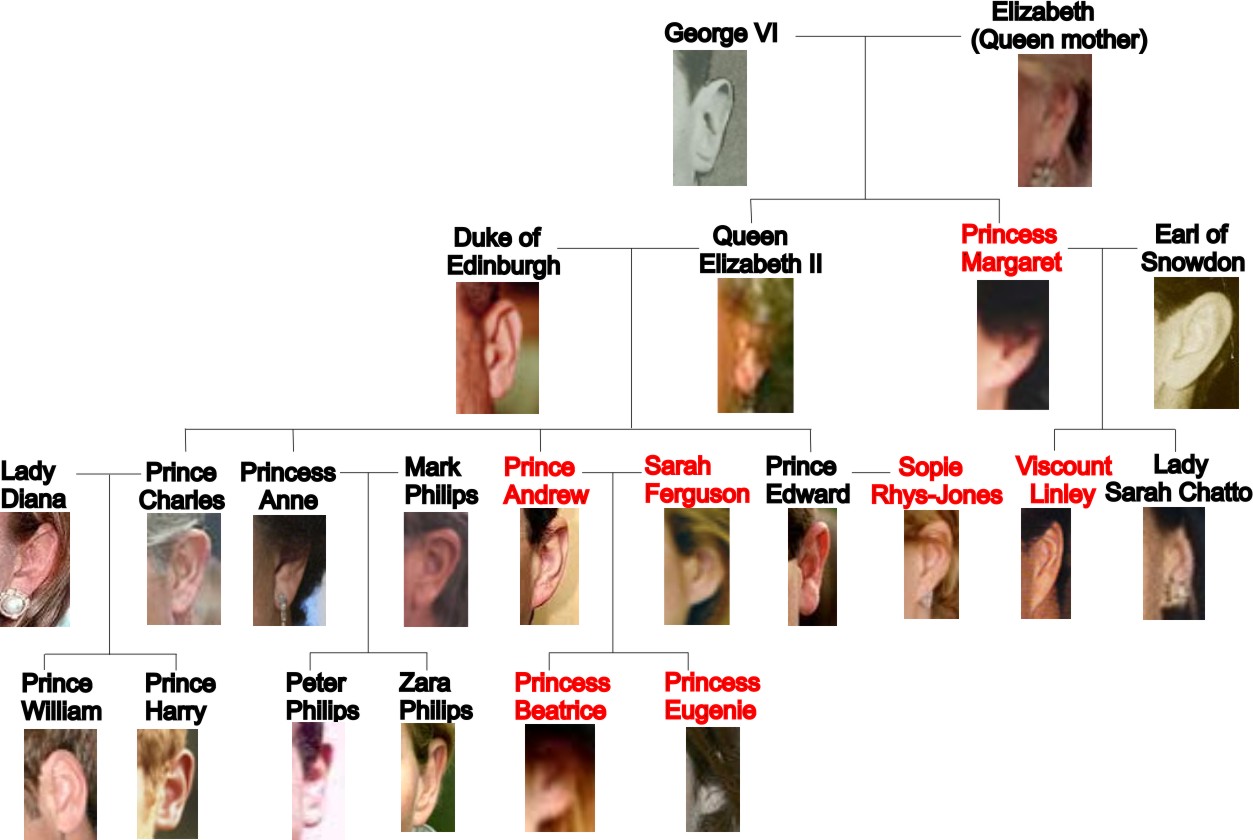

This tends to show a pattern whereby the gene allele for detached earlobes (E) is dominant over attached (e). Therefore, heterozygotes containing both an allele for detached and one for attached earlobes have detached ears. And if two such heterozygous parents produce children, then there is one in four chance of any of their offspring inheriting both attached alleles and so showing attached earlobes; the classic 3:1 ratio.
Prince Andrew and Sarah Ferguson both have attached ear lobes (suggesting that they are e/e), and their two daughters seem to have inherited the same trait. This would imply that both Queen Elizabeth (her sister had attached ear lobes) and the Duke of Edinburgh are heterozygotes (E/e), as one of their four children (Andrew) shows attached ear lobes.
Recessively inherited disorders occur in the same way, only resulting if two copies of the defective gene are inherited. Inheriting only one defective copy will not lead to any ill-effects as a second functional copy of the gene will compensate. So while a dominant disease requires only one parent to carry the gene, a recessive disease can only result if both parents have at least one copy of the defective gene.
Furthermore, only 25% of the offspring of two such heterozygous (i.e. they only carry one mutant copy of the gene) parents will show the disease. We can see this if we assume the dominant non-disease causing gene as the ‘D’ and the recessive, disease-causing, gene as ‘d’.
In recessively inherited disorders the parents are often unwitting heterozygous carriers of a gene in which children inheriting two copies suffer from the disease. The family tree of a recessive gene is very different from a dominant one, as only one or two generations will suddenly show the disease when individuals with the same gene marry.
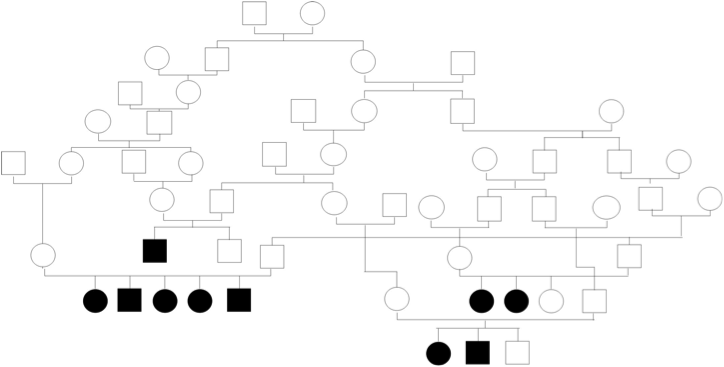
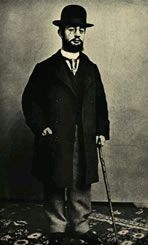
The ancient taboo of incest in most cultures probably stems from the realisation that inbreeding, particularly within the first generation, leads to higher occurrences of children born with defects. The reason inbreeding is so deadly to a population is that, while normally only a small minority of the general population will carry a copy of a particular gene causing a specific recessive disease (i.e the chance of marrying a carrier of the same recessive gene is low), this chance will increase if the individuals are related and hence share some genetic material. Therefore, some recessively inherited conditions are found in higher frequencies in some close-knit communities such as Amish or various Jewish communities. Another example of inbreeding leading to higher incidents of genetic diseases can be seen in the Negev Bedouin people, a population of 140,000 people who roam the Negev desert in Southern Israel. Their tradition is to marry within the family so as to strengthen bonds among extended families; around 65% marry their 1st or 2nd cousins. Although they do not carry any more mutations than the general population, because so many marry relatives they have a higher chance of marrying someone carrying the same mutation increasing the odds of producing a child with a recessive genetic disease. In fact, many of the diseases seen in the Bedouin are extremely rare, resulting from mutations not previously seen in other populations of the world, due to their cultural isolation.
The French painter Henri de Toulose-Lautrec was born from a first-cousin marriage with the recessively inherited bone disorder Pycnodysostosis. His parents must have both had a copy of the mutated gene for the disease and at least three of his cousins, the offspring of his paternal uncle married to his maternal aunt, also suffered from the same disorder, supporting the mode of inheritance being autosomal recessive and exemplifying again the risks of inbreeding.
Charles Darwin, along with his cousin Francis Galton who coined the term eugenics, was one of the first to realise the ill effects of inbreeding and the advantages of cross-breeding. His theories may have actually stemmed, to some degree, from his own experiences as he himself married a cousin Emma Wedgwood in 1839. They had ten children with seven either dying prematurely or remaining childless; although dozens of his descendants nevertheless became eminent, particularly in the fields of science.
SEX-LINKED
When a gene for a genetic disease occurs on the X chromosome as opposed to one of the autosomes, X-linked recessive inheritance is seen (X-linked dominant inheritance is rare).
This inheritance is characterised by a high preponderance of male sufferers – in contrast to the inheritance of traits on autosomal chromosomes, where both sexes have the same probability of expressing the trait.
The reason females are less affected by X-linked recessive diseases is due to the presence of two X chromosomes. They can carry the affected gene on one X chromosome without developing the disease but can pass it on to their sons, i.e. women are unaffected heterozygotes, or carriers.
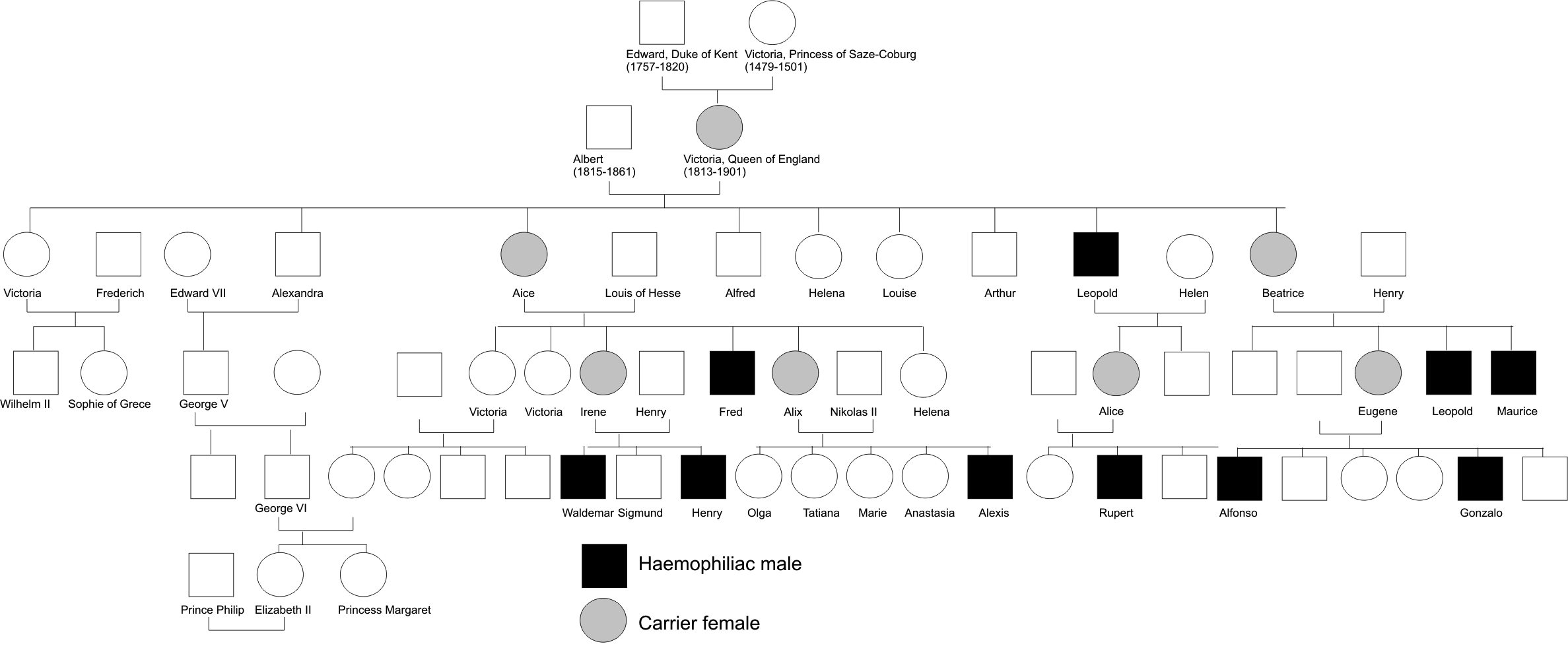
We can see this in the inheritance of the X-linked recessive disease Haemophilia, in the British royal family. Queen Victoria was almost certainly a heterozygous carrier of the haemophilia gene, which she passed on to one of her sons, Leopold, who subsequently suffered and died from the disease. Interestingly, Queen Victoria had no ancestors with the condition and so serves as an example of how a disease can arise due to a spontaneous mutation; although there are suggestions that she may have been illegitimate. Prince Leopold then passed on his mother’s gene to his daughter, Alice, who subsequently gave birth to a haemophilic son. Two more of Queen Victoria’s daughters, Alice and Beatrice, were also carriers of the haemophilia gene, which they transmitted to several royal families in Europe, including Spain and, more famously, Russia with the birth of Alexis, the son of Tsar Nicholas II of Russia.
MITOCHONDRIAL INHERITANCE
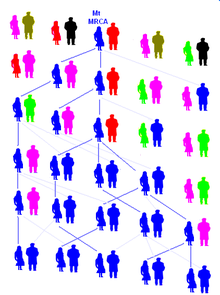
During sexual reproduction mitochondria are passed on to offspring only through the egg and not the sperm as it is only the nucleus of the sperm that enters the egg during fertilisation. Therefore, only females can pass on mitochondria and mitochondrial diseases such as mitochondrial myopathies and Leber’s congenital optic neuropathy.
The fact that the mtDNA we carry in our cells has been carried through a direct line from our very distant maternal ancestors. Forms the basis of the ‘Eve Theory’ in which all mitochondria present in the whole human population originate from a single, or small handful of, women who lived around 100,000 years ago.


As mutations occuring in mtDNA are passed on only through females it is possible to determine to what extent individuals share the same maternal ancestor. This was used to test the late Russian imperial family and the fate of one of the Tsar’s daughters, Anastasia, who was presumed executed along with the rest of her family on July 17, 1918. However, rumours spread that Anastasia might have survived and in 1991, when the bodies of the Russian royal family were exhumed, Anastasia’s bones were indeed missing.
In 1922 a woman, later called Anna Anderson, claimed to be Anastasia, and although she could not speak a word of Russian, many people were convinced. To determine if her claims were true her mtDNA was taken after her death, and compared to mtDNA extracted from the bones of Anastasia’s mother, the Czarina. As a control, mtDNA from England’s Prince Philip, who is related on the maternal side to the Czarina, was compared to the Czarina and indeed showed significant relatedness. However, Anna Anderson’s mtDNA showed very little similarities to the Czarina’s mtDNA leading one to conclude that she was not Anastasia.

One possible identity of Anna Anderson was a woman by the name of Franziska Schanzkowska, a Polish factory worker who disappeared at about the same time that Ms. Anderson appeared in Germany claiming to be Anastasia. Analysis of mtDNA from a grandnephew of Franziska Schanzkowska revealed strong similarities, suggesting that Anna and Franziska were the same person.
MULTIFACTORIAL

Many common traits and diseases show multifactorial inheritance where there is more than one genetic factor involved and, where environmental factors can participate in the development of a condition. These conditions tend to “run in families” but do not show typical patterns seen with the Mendelian inherited dominant or recessive diseases.
Skin color, for example, is multifactorially determined, as is height and intelligence.
Many common diseases tend also to multifactorial. Type 2 diabetes, for example can develop due to the inheritance of certain susceptibility genes and environmental factors such as obesity.
American singer and actress Patti Labelle was diagnosed with type 2 diabetes after she passed out onstage during a concert. Determined not to die of the same disease that killed her mother she took more charge of her health, losing 20 pounds of weight lighterand even has her own cookbook called Patti LaBelle’s Lite Cuisine as well as becoming a diabetes spokesperson.
EPIGENETICS
Found only in mammals, this phenomenon of gene imprinting has only relatively recently become understood. However, the idea that maternal and paternal chromosomes differ is an ancient one. For instance, this can be seen in the old practice of mating a female horse with a male donkey to produce a mule; an animal prized for its very hardy temperament. In contrast, mating a male horse with a female donkey produces a hinny. These animals, which like mules are sterile, are generally smaller than a mule and have heads more similar to a horse with smaller ears. This highlights the fact that the genetic contribution from male and female sexes of the same species of an animal is different. George Washington, who liked to breed mules, also realised this. After begging the King of Spain to oppose the ban on exporting the huge Catalonian donkeys, he was eventually rewarded with a Spanish donkey, called the Royal Gift, which he used to sire many mules. Quickly gaining a reputation for being impressively tough, it soon seemed like half the farmers in Virginia owned one of Royal Gift’s descendants.
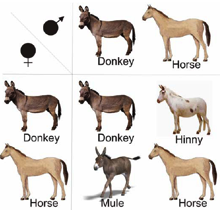
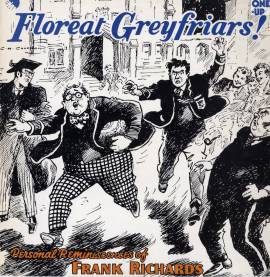
Epigenetics (Gr. epi, above) is the study of changes produced in gene expression independent of DNA sequence. Two examples of mechanisms are the methylation of DNA or the modification of histone proteins making up chromatin.
The term was coined by C. H. Waddington in 1942 to describe the differentiation of cells during development, i.e. a skin cell and a neuron have the same DNA sequence but obviously different perform different jobs. When Waddington coined the term the physical nature of genes and their role in heredity was not known; he used it as a conceptual model of how genes might interact with their surroundings to produce a phenotype.
This phenomenon of epigenetics is able to explain how a foetus of any mammal cannot develop when both sets of chromosomes derive from the same parent. This is due to the fact that a small number of particular genes are epigenetically modified and expressed according to their parent of origin, i.e. they are only functional on either a maternally or a paternally inherited chromosome. This is called genetic imprinting. This means that a foetus inheriting two maternal sets of chromosomes will have twice the normal expression of some imprinted genes that are only expressed on the maternal chromosomes and a complete lack of proteins that would normally be expressed from the paternal chromosome – such a scenario is not compatible with life.
One theory proposes that some genes provided to the offspring by the father try to extract as many resources from the mother as possible while maternally inherited genes, by contrast, are not interested in exhausting maternal resources prematurely, but rather in ensuring that these resources are conserved for future offspring. It is therefore suggested that evolution selected for the phenomenon of genetic imprinting in order to control this. While only a small percentage of our genes are imprinted, mutations affecting one of these will lead to disorders which differ depending on whether the gene defect was inherited from the mother or father. For example, an individual missing a small piece of chromosome 15 from the mother will be born with Angelman syndrome, manifesting itself with mental retardation. In contrast, if the abnormal chromosome 15 is inherited from the father the offspring will present with Prader-Willi syndrome characterised by lower IQ, small stature and a tendency for overeating, leading to obesity, later in life. Such individuals incorrigibly steal and hide food, like the fictional scallywag Billy Bunter who, with his inept ability for snaffling food, displays characteristics of Prader-Willi syndrome.
The molecular basis of epigenetics is complex and involves modifications of the activation of certain genes, but not the basic structure of DNA. This can play a role in what has come to be known as cell memory. A genome can pick up and lose epigenetic markers, such as regions of methylated DNA (describing the addition of methyl groups to cytosine residues in the DNA) or remodelling of the chromatin proteins that wrap around the DNA, more rapidly than it can change DNA sequence. This allows cells and organisms the ability to quickly respond to the environment in an inheritable way.
INHERITANCE OF ACQUIRED TRAITS
The possibility of the inheritance of acquired traits was first proposed by the French naturalist Jean Baptiste de Lamarck who speculated that environmental cues could cause phenotypic changes transmittable to offspring. To explain this he used the evolution of the giraffe as an example. He speculated that giraffes once had necks no longer than those of zebras, but as the early giraffes stretched their necks to feed from the highest limbs of a tree, their necks got longer and longer. This acquired trait was then presumably passed on to subsequent generations of giraffes who would be born with progressively longer necks. Sadly, the use of this seemingly absurd example, invited criticism and even scorn from contemporary scientists. The German scientist August Weissman “tested” Lamarck’s theory by cutting off the tails of generations of mice and proclaiming that none were ever born without tails. Interestingly though, it is speculated that his experiment when conducted over many generations of mice might, theoretically, lead to tailless mice as his tail amputation procedure could introduce infections, and so a mouse born without a tail, even if an extremely rare event, might have a greater advantage.


During the Second World War, a German-imposed embargo in an area of Holland, already suffering from severe food shortage and the onset of a very harsh winter, led to the death by starvation of over 30,000 people. Analysis of birth records from this time reveal a link between prenatal exposure to this famine and the development of various health problems in the subsequent children such as low birth weight, diabetes and obesity suggesting that a pregnant mother’s diet can affect her children. In addition, there is evidence linking this famine and a famine in China to increased risk of schizophrenia. This could give some credence to popular beliefs relating to birth signs, i.e. the idea that the time of year of birth affects personality. Children born in the winter months would have been exposed to a different prenatal-diet than those born in the summer (though in modern times this effect is less pronounced since the food available in supermarkets hardly varies seasonally). However, a particularly significant finding of this so-called “Dutch Hunger Winter Study” was that the grandchildren of women who experienced starvation tended to have smaller birth weights supporting the idea of the inheritance of characteristics acquired during lifetime.
A further study on a small isolated population in northeast Sweden found a greater body mass index (BMI) at 9 years in sons, but not daughters, of fathers who began smoking early. The paternal grandfather’s food supply was also linked to mortality risk of grandsons and not granddaughters, while the paternal grandmother’s food supply was only associated with the granddaughters’ mortality risk ratio.
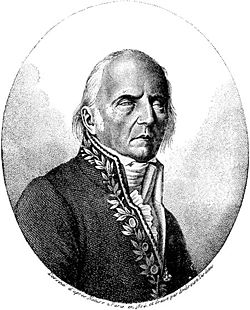
All this came too late for Lamarck who sadly died penniless in 1829 and was buried in a rented grave. However, he is now starting to receive the recognition he deserved for his contribution to natural science.
